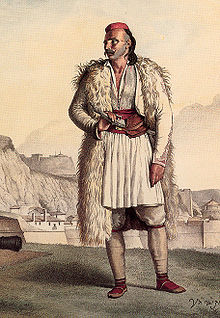Albanian Regiment (France)
[2][4] Soon the Souliotes, along with Himariotes, Acarnanians, and Moreotes, were recruited into the Greek Legion, which was placed under the command of the Greek-born Russian Major-General Emmanouil Papadopoulos.
[7][8] The majority of the legionnaires received recommendation letters from the Russian army and were recruited into the French Albanian Regiment under the condition of never fighting against Russia.
Berthier initially suggested to create independent Greco-Albanian companies to serve alongside regular French line infantry regiments as skirmishers (tirailleurs) or light mountain infantry (chasseurs de montagne), and even proposed that two such companies be attached to the royal guards of Napoleon and his brother Joseph Bonaparte, the King of Naples.
This agitation may have resulted in part because the Souliotes, whose loyalty was determined by ties of kinship rather than any formal military hierarchy, were unwilling to accept being subordinated to a commander not of their own clan.
[12] A prominent member of the corps, Christoforos Perraivos, provides an entirely different explanation in his memoirs, whereby Kalogeros had incurred the enmity of his fellow officers after denouncing his previous allegiance to the Russian Emperor to the French.
[13] The French authorities initially tended to view this mutiny with hostility,[11] and the difficulty of dealing with the intransigent former Legion members led to Berthier having a very low opinion of them.
[14] In the end, on 12 December, the French established the Albanian Regiment (Régiment albanais) with a nominal strength of 3,254 men in three battalions of nine companies each, and a 14-member command staff.
[11][15] The first three battalion commanders were the Moreote Anagnostaras, the Himariote Konstantinos Androutsis (a veteran of the Neapolitan Army), and Kalogeros, although by February 1808 he was replaced by the Souliote Fotos Tzavellas.
[28] Ali Pasha was also suspected to be behind the deaths of Fotos Tzavellas, who died on 4 November 1810 of a sudden illness, as well as the murder of Kitsos Botsaris by Gogos Bakolas in Arta in 1813.
[31] These forces were completely inadequate to offer anything but a token resistance; the captured men were transferred to Italy as prisoners of war, but more than a few of the Regiment's men—up to about half in Zakynthos—simply scattered into the countryside and resumed their traditional guerrilla habits.
This decision not only left the lightly equipped men of the Albanian Regiment exposed to the elements, but Camus also refused to give shelter to their families in the fortress.
[33] Indeed, from the reports of the British and the memoirs of the Greeks already enlisted to fight in their ranks, it is clear that the men of the Albanian Regiment resisted the initial offer to defect, and only surrendered after their situation had become hopeless.
[34] After the fall of Lefkada, Colonel Kitsos Botsaris, as the senior native Regiment officer, was court-martialled on suspicion of contacts with the British, but acquitted.
[39] The proposal was not supported by the French governor-general, François-Xavier Donzelot, who preferred to keep the Regiment in Corfu, albeit reducing it to the "best" elements, with the remainder used to form a depot.
[39] Unlike Minot, Donzelot was keen to attend to the welfare of the Regiment's men, even going as far as taking a personal loan of 100,000 francs (for which he was never fully repaid by the French government) to cover their arrears in pay.
Donzelot, however, intervened with the British, suggesting to either take the men of the Albanian Regiment into their service, or at least undertake to maintain them for two months, during which they could return to their homelands.
This was not only because the French military threat had been removed, but also in reaction to Ottoman protests at the existence of Greek armed units, and the British hopes to secure their control over the Ionian Islands with the diplomatic assistance of the Sublime Porte.
A three-man delegation comprising Perraivos, Major Dimos Doukas, and Kitsos Tzavellas, set out to meet the Corfiot noble Ioannis Kapodistrias, who had served with them in the defence of Lefkada in 1807 and now was the principal advisor on foreign affairs to Tsar Alexander I of Russia in the Congress of Vienna.
[44] All non-British military formations were disbanded and even forbidden, with the exception of police and militia, while the large proportion of mainlanders active in the various regiments raised by the Russians, French, and British were prohibited from holding any position in them by restricting eligibility to native Islanders.


